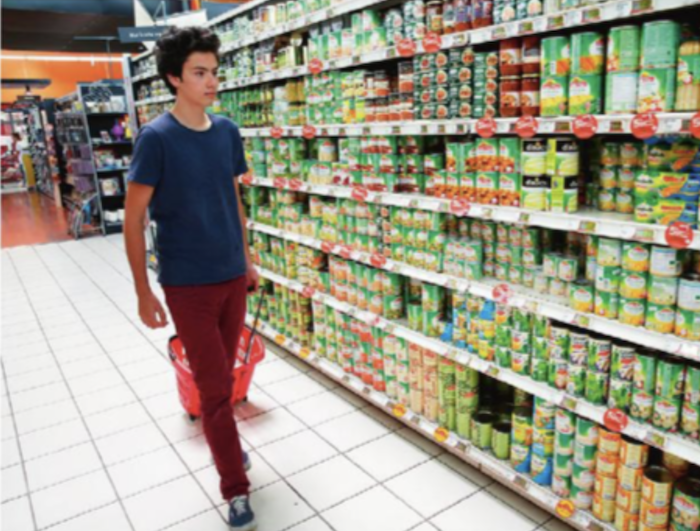Question : Consumption and conformity; How do consumers make decisions?
Objectifs : Understand the various influences for consumers.
Resources :
Video: Social Conformity
PDF: 80 km/h: Four times the Vandalism
PDF: Séance 1 évaluation
Contents
Activité 1
Consumption is an economic, political and social choice.


Consumption is an economic, political and social choice.
With identical characteristics, when purchasing, the rational consumer buys the cheapest product.
In reality, the elements which determine the consumer’s choice are more varied than the single product price: the products are not homogeneous, there may be substitution of a choice by the other to satisfy a need, the social environment can also influence choices.
The consumer may prefer to own the film for a long time rather than go to the cinema once, they can prefer to go with our friends, they can choose the cheapest option…
The influence of others can be achieved through different means (role of « influencers » on social networks for example), a consumer can choose (consciously or not) to behave like a model, or a personality that we imitate (a loved one or a star). But we can also differentiate ourselves by consuming differently (imitation versus differentiation, this is easy to illustrate in fashion).
Governments can encourage us to consume certain products or services by subsidizing (ex: electric cars) but they can also discourage us from consuming certain products (ex: tobacco tax) or even prohibit certain types of consumption (ex: drug interdiction). Political decisions exist through the creation of laws.
Activité 2
Conforming behaviours
For this experiment, a group of accomplices is installed in a waiting room. At each « beep », the group gets up and sits down. Quickly, they are joined by a woman who is about to be trapped, we’ll call her the « guinea pig ». At first perplexed, the subject quickly conforms to the actions of the group … and that’s not all.
First, in a waiting room, a group of « accomplices » get up and sit down at the sound of a beep. This behaviour will first cause surprise for the guinea pig and then adhesion when the subject replicates the group behaviour.
Secondly, the guinea pig continues to stand up while the accomplices have left. It even continues with the arrival of another person who will in turn adopt the initial behaviour.
Individuals adopt this compliant behaviour because in a situation of uncertainty (what to do when the « beep » sounds?) we tend to reproduce the behaviour of others. It is also the will not to be noticed (being the only one not to stand up as in experience) that prompts individuals to adopt compliant behaviours.
Our behaviours are partly dictated by the social world around us (social determinisms) with its rules and values. We share the same culture, we adopt consistent behaviours. But if our environment forces us, there is a margin of freedom and choice.
Fashion can be an example of a social situation where the behavior of individuals is influenced by the group but where they remain free to choose or even modify the modes.
Activité 3
The state and the law
Read the text: 80 km/h: Four times the Vandalism
The institutions that participate in the promulgation of a law (government, parliament with deputies and senators).
The objective of the law limiting the speed to 80 km/h on a section of the departmental roads is to limit road accidents.
Yes, however failure to comply with the law is punished. But in a democracy, the law can evolve or even change as a result of a political decision. This may be influenced by social movements (ex: the vote for women, marriage for all).
Evaluation
Answer questions about this lesson.
How do economists, sociologists and political scientists reason and work? – Séance 1
Quiz Summary
0 of 15 questions completed
Questions:
- 1
- 2
- 3
- 4
- 5
- 6
- 7
- 8
- 9
- 10
- 11
- 12
- 13
- 14
- 15
Information
You have already completed the quiz before. Hence you can not start it again.
Quiz is loading...
You must sign in or sign up to start the quiz.
Vous devez d’abord complété le suivant :
Résultats
Résultats
0 of 15 questions answered correctly
Your time:
Temps écoulé
You have reached 0 of 0 point(s), (0)
Earned Point(s): 0 of 0, (0)
0 Essay(s) Pending (Possible Point(s): 0)
| Score moyen |
|
| Votre score |
|
Catégories
- Pas classé 0%
-
Zut !
On dirait que vous devez vous entraîner un peu plus. Pourquoi ne pas revenir à la leçon et, quand vous êtes prêt, recommencer le quiz ?
-
Dommage !
Vous n’étiez pas loin de réussir ce quiz. Vous pouvez recommencer le quiz ou d’abord voir où vous vous êtes trompé.
-
Bien joué !
Vous n’étiez pas loin d’obtenir 100% ! Vous pouvez essayer à nouveau le quiz pour obtenir un score parfait, ou passer à la section suivante.
-
Félicitations !
Vous avez eu 100% sur ce quiz !
- 1
- 2
- 3
- 4
- 5
- 6
- 7
- 8
- 9
- 10
- 11
- 12
- 13
- 14
- 15
- Répondu
- Révision
-
Question 1 de 15
1. Question
If two items are of identical quality, what element will determine the consumer’s choice at the time of purchase?
ExactInexact -
Question 2 de 15
2. Question
Why can we not compare the choice of a cinema ticket for €10, and a download of a film for $15?
ExactInexact -
Question 3 de 15
3. Question
Under influence from other people, what decision does a consumer make (consciously or not)?
ExactInexact -
Question 4 de 15
4. Question
How might governments encourage a purchase?
ExactInexact -
Question 5 de 15
5. Question
How might governments discourage a purchase?
ExactInexact -
Question 6 de 15
6. Question
How might governments prohibit a purchase?
ExactInexact -
Question 7 de 15
7. Question
In a situation of uncertainty, what actions do we tend to take?
ExactInexact -
Question 8 de 15
8. Question
What is the punishment for degrading a standing radar?
ExactInexact -
Question 9 de 15
9. Question
Why would the state place standing radars?
ExactInexact -
Question 10 de 15
10. Question
How can a citizen change a law?
ExactInexact -
Question 11 de 15
11. Question
What is a synonym of “peer-pressure”?
ExactInexact -
Question 12 de 15
12. Question
What is a synonym of “increase by four times”?
ExactInexact -
Question 13 de 15
13. Question
What is a synonym of “declared a law”?
ExactInexact -
Question 14 de 15
14. Question
What is a synonym of “obey a law”?
ExactInexact -
Question 15 de 15
15. Question
What is a synonym of “of the same kind”?
ExactInexact